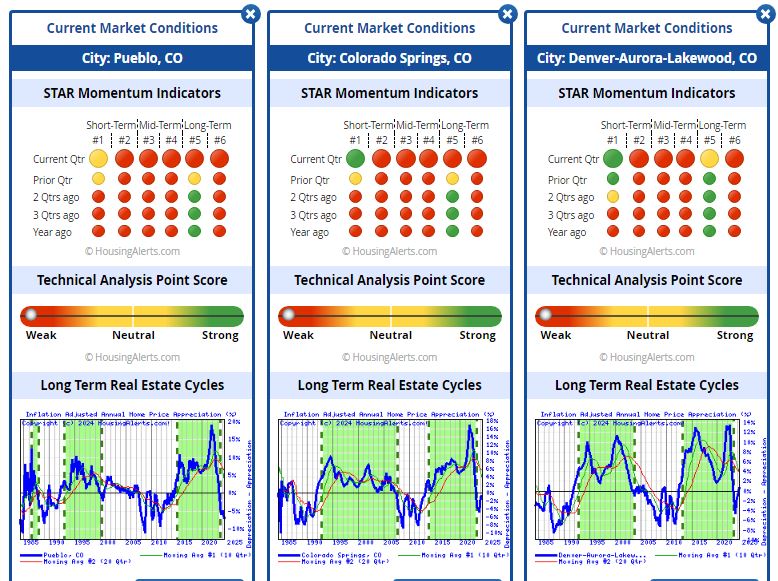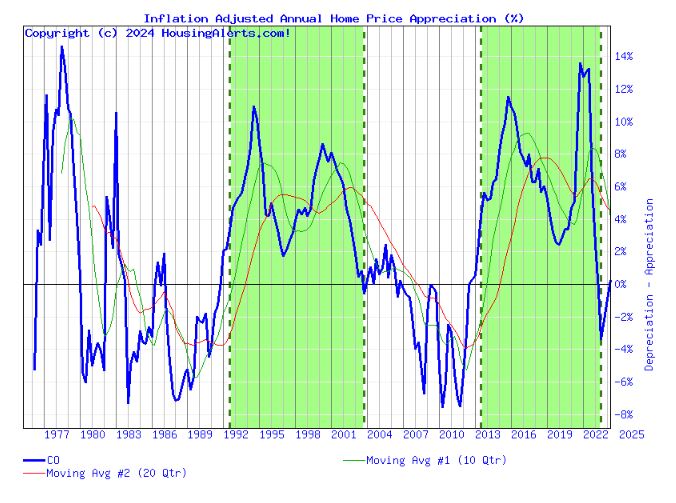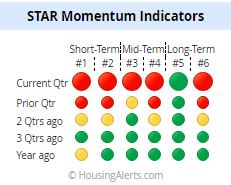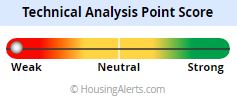Current Status of Front Range Cities Denver, Colorado Springs, and Pueblo
This page is a snapshot of the state of the real estate market from Colorado Springs, Denver area, and Pueblo. Shown below are three graphs of the status of each of these markets (Figure 1.) As I’m most interested in the Front Range of Colorado from Denver to Pueblo, I’m including snapshots of what’s happening there. Generally, green means good for a seller, and red means good for the investor.

Analysis
The market for Colorado Springs, Pueblo, and Denver is stronger than it was in December 2023 with an uptick toward appreciation. All three STAR momentum indicators look virtually identical being red, with the #5 market indicator long-term indicator showing green. Denver and Colorado Springs short-term #1 indicators for the current quarter are both green. The Technical Analysis Point Score (TAPS) graphs showing all these areas are solidly weak.
State of Colorado
From a wealth accumulation point of view, Denver, the largest market in Colorado, reflects the state of Colorado. The three individual graphs indicate that the Denver metro and Colorado Springs areas have turned positive almost back to neutral, while Pueblo is lagging showing no real recovery. Colorado as a whole remains a weak market.
Notice from Figure 2 that the long-term and short-term moving averages are close to crossing. When those two lines cross over we can we expect the market to grow again.
Figure 2 shows the wealth accumulation as a percentage of the state of Colorado. Green areas are when the market is appreciating and white areas are when the market is depreciating. But if you look at the green (10 quarters) and red (20 quarters) lines of moving averages, you’ll notice that the market changes when these two lines cross over each other. You can see at the far right that these two lines are close to crossing over signifying a significant change in market direction for Colorado into a possible appreciating phase. We’ll have to wait and see if this plays out.
The Dow dropped yesterday (8/5/2024) 1000 points. The volatility index jumped 165% in one day!! This is almost as high as during the subprime melt down of 2008 and Covid in 2020. So, I’d take a wait and see attitude for the continued climb in Colorado real estate.

Explanation of graphs
The first set of graphs (Figure 3) is the Six Trigger Alert Reports (STAR). There are six momentum indicators ranging from short-term indicators on the left to long-term indicators on the right for Denver, Colorado Springs, and Pueblo. Normally, green is good if you’re a seller, and red is good if you’re a buyer. (Normally, but the market is a little wonky because of the really low-interest rates people got on their houses during 2020-2022.) The indicators go back in time as you go down each row on the graph.

The indicators for the current quarter (top row) suggest that the short-term through long-term indicate a weak seller’s market for Colorado. A year ago, all the momentum indicators except for Short-Term #1 were green. (These graphs are from HousingAlerts.com. This is just a quick snapshot of what HousingAlerts.com has to offer. Go to my home page to get a free version for your state.)
The next graph (Figure 4) indicates the Technical Analysis Point Score (TAPS.) Each market is graded using a series of technical criteria. (I don’t really know the details.) Again, green is good for home sellers, and red is bad for home sellers, but good for investors. You can see that Colorado has moved into the weak zone.
